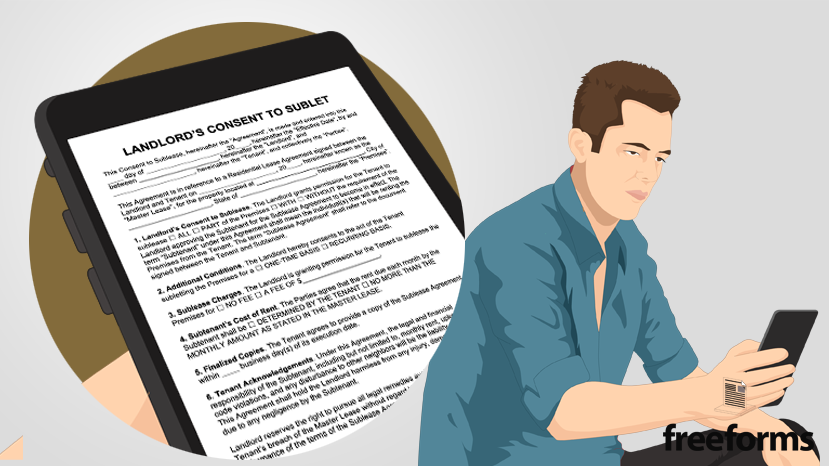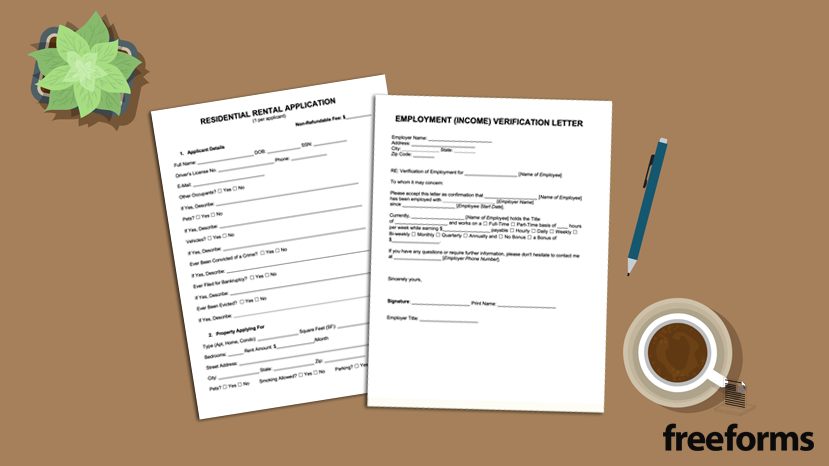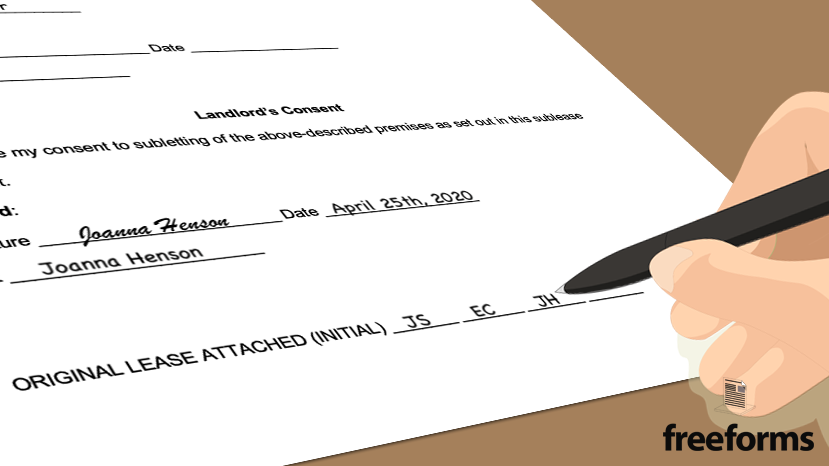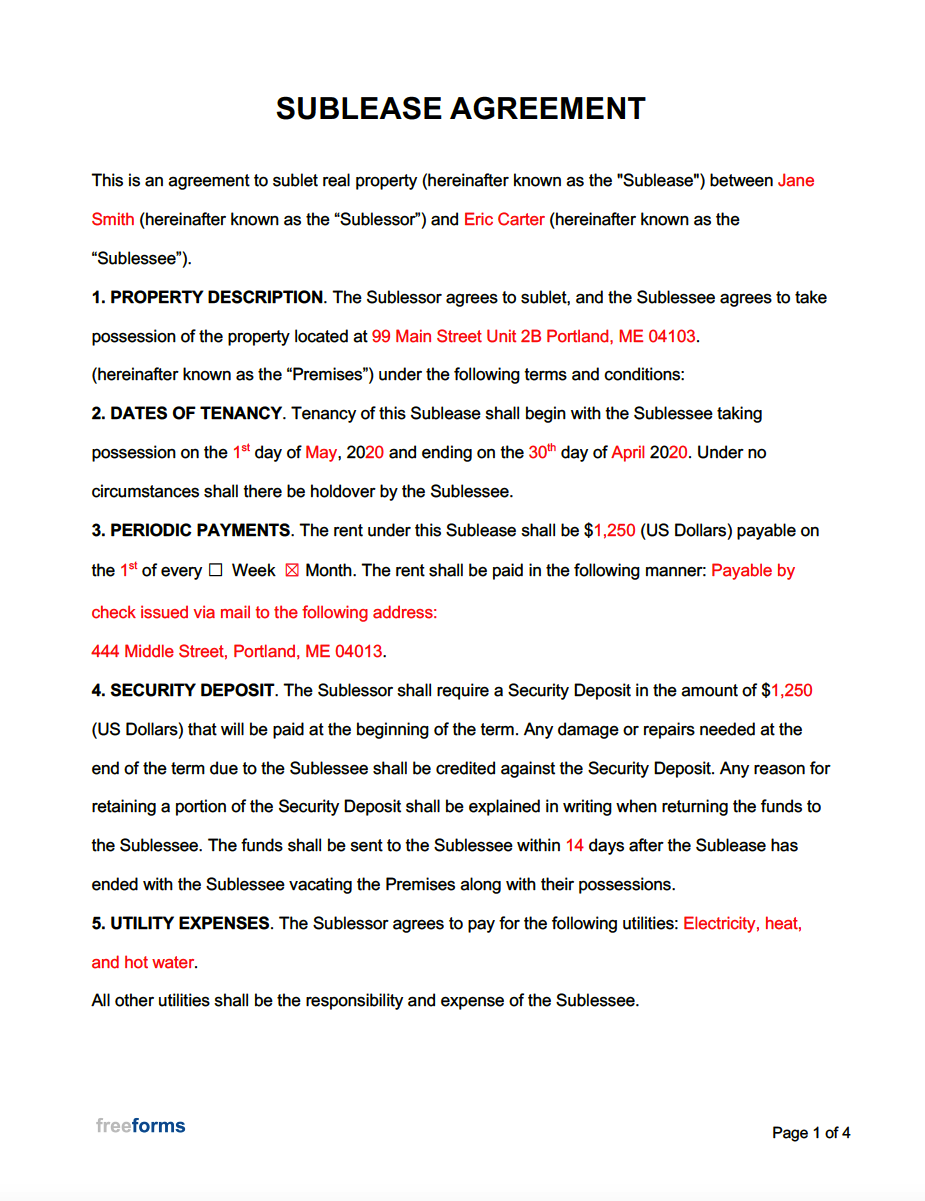The paperwork covers the typical conditions of a regular lease which are applied to the new relationship between the actively renting tenant and the subtenant. A signified amount of time and monetary compensation are the most crucial elements of the arrangement and should be recorded within the contract. Additional terms and conditions to the subtenancy are also mapped out in the accompanying provisions which must comply with the stipulated bonds created in the original lease agreement.
Landlord’s Consent to Sublet Form – To effectively sublease a property, the occupying tenant must first have the legal ability to do so. If there is no indication of a right to sublease in the original rental contract, then this form can be executed to convey that the landlord agrees to the subletting of the premises.
By State
- Alabama
- Alaska
- Arizona
- Arkansas
- California
- Colorado
- Connecticut
- Delaware
- Florida
- Georgia
- Hawaii
- Idaho
- Illinois
- Indiana
- Iowa
- Kansas
- Kentucky
- Louisiana
- Maine
- Maryland
- Massachusetts
- Michigan
- Minnesota
- Mississippi
- Missouri
- Montana
- Nebraska
- Nevada
- New Hampshire
- New Jersey
- New Mexico
- New York
- North Carolina
- North Dakota
- Ohio
- Oklahoma
- Oregon
- Pennsylvania
- Rhode Island
- South Carolina
- South Dakota
- Tennessee
- Texas
- Utah
- Vermont
- Virginia
- Washington
- West Virginia
- Wisconsin
- Wyoming
What is Subletting?
Subletting is the act of re-renting a leased property to a third (3rd) party. The terms “sublet” and “sublease” fundamentally mean the same thing and are used interchangeably. The two (2) parties that will be involved in the sublease agreement are referred to as the:
- Sublandlord/Sublessor – The individual who is actively in a rental agreement with the primary landlord of the property, i.e., the original tenant.
- Subtenant/Sublessee – The third (3rd) party renter who will be subleasing the property from the original tenant.
It is important to note that in order to achieve a successful sublet, the initial lease agreement must contain a paragraph that sanctions it or the sublessor must get written approval from the property’s actual landlord.
How to Sublease a Rental Property
If you are currently leasing a property for a fixed-term and thinking you may have to break the lease, whether it’s because you need to relocate, can’t afford the rent, or any other reason, subletting the premises to another individual may be a favorable alternative for you. Contained within this section is a comprehensive guide that can help you execute a sublease in an efficient manner. Follows the steps below to get a better grasp on how to properly sublease your rental property.
Step 1 – Revisiting the Original Lease Agreement

The first step requires the tenant to locate the primary rental contract put into effect on the commencement date of the current occupancy. Peruse through the document and search for any clauses that mention the lessee’s rights in regard to subletting the premises. If there is a provision that grants the occupant the authority to carry out a sublease, then they may do so as long as they don’t violate any of the conditions included within the paragraph.
Step 2 – Consulting With Your Landlord

Tenants with lease agreements that do not contain a sublet clause will need to contact the landlord for the purpose of receiving permission. It is paramount that you receive the approval in written form and signed by the landlord themselves. A formal document that can be utilized for this purpose would be the:
- Landlord’s Consent to Sublet Form – This may be implemented in order for the primary landlord of a rental unit to convey their permittance of a subtenancy. Within the content of the form, the individual may stipulate various conditions concerning the sublet.
(Note: It is up to the sublessor as to whether or not they prefer to accomplish this step before or after finding a subtenant. But, keep in mind, if you do go through all the hoops of finding a new occupant without previously requesting the endorsement of the landlord, then you may run the risk of being denied in the future.)
Step 3 – Establishing the Sublease Payments

Hopefully, you have achieved the pre-authorization to sublease the premises from the landlord. It is now time to figure out how much you should charge for the sublet. This could depend on several factors, such as:
- Marketplace – What are similar properties going for? Scan the various rental websites to get a general concept of what the current rates are for comparable units. Who knows, you may even be able to make a decent profit if the housing market is prospering.
- Urgency – Do you need to re-rent the property as soon as possible? Sublessors who are in a bind for time or money should try to offer the best deal possible to entice renters to sublease the property immediately.
Step 4 – Finding a Subtenant

The subsequent measure entails the original lessee actually finding a trustworthy subtenant to occupy the premises. If it is a possibility, it is always optimal to sublet to an individual that you may know in your personal life as a dependable person. But, if you do not know anybody who is presently looking for housing, the next best option would be to market the property online in order to attract potential subtenants. To do this, you are going to want to create an advertisement on one of the following popular websites devoted to the transfer of rental properties:
- Sublet.com – One of the few websites that is primarily dedicated to the exchange of subleased properties.
- Craigslist.org – Under the category “Housing”, there is a subsection labeled “Sublets/Temporary” that is specific to short-term rentals.
- Airbnb.com – Mainly famous for its day-to-day vacation rentals, Airbnb also contains a sublet division that caters to those seeking to rent property on a monthly basis. (Apart from the agreements made on the site, sublessors may also demand that the new tenant sign a sublease upon their arrival to the property. With that being said, they must disclose that this action is required before the booking is finalized.)
- Zillow.com – Although this site is not specific to the advertisement of sublets, it is still one of the top websites for rental properties in general. (Users do have the capability of indicating that the property is only available for so many months.)
Step 5 – Showing the Unit

As long as the unit is sensibly priced, the party advertising the property should be reached out to by those interested in the sublet. They should make sure to keep up with any phone calls, text messages, or emails received. Sooner or later, one of the prospects will request to personally see the unit. Maximize the effectiveness of your showings by:
- Maintaining Cleanliness – Make sure that the home is as clean as possible. This means that you wipe down the surfaces, vacuum & wash the floors, and pick up any clutter.
- Be Accommodating – People are more receptive and trusting to those who act in a professional manner. Make them the priority by promptly responding to any inquiries they may have, scheduling a date & time to view the property that is convenient for them, and being punctual upon the time of the showing.
- Have Paperwork Ready to Go – Plan ahead and collect any documentation that can be of use when meeting with prospective subtenants. This could include a rental application, sublease agreement, written consent from the landlord, master lease, etc.
Step 6 – Screening a Potential Subtenant

The individual seeking to sublet their rental unit should realize that even though they will be renting out the property to a new tenant, they are still held liable for the content of the initial lease agreement. That is why it is so consequential to have confidence in the subtenant you select. To further verify a sublessee’s ability to rent, sublessors can use the following tools:
- Employment (Income) Verification Letter – A form that indicates who the prospective subtenant works for, what their title is, and how much they’re paid periodically. Their employer must then sign off on the document confirming that the information is true.
- Rental Application – Typically carried out by property owners and management companies, this is a more wide-ranging screening document that additionally covers the applicant’s past occupancies, criminal history, and financial & credit backgrounds. (Various websites such as MySmartMove.com and RentPrep.com offer to run the collected data through a database in exchange for a fee.)
Step 7 – Settling on the Terms & Conditions

In the midst of negotiations, it is not unheard of for renters to request that certain concessions be made relative to the terms & conditions of the sublease. Participants of the transaction should communicate about the following key elements of the subtenancy:
- Term – The duration of time that the sublessee has possession of the premises.
- Costs – What will be the amounts charged for the monthly (or weekly) rent, damage deposit, and utility services.
Step 8 – Fulfilling the Sublease Agreement

If the original tenant finds an individual who has passed the screening and accepted the terms of the sublet, then they can now present them with the sublease agreement. All the terms & conditions previously agreed upon must be typed (or written) into the form. Once it is filled out, each party should double-check the information and furnish the following signatures:
- Sublessor’s Signature
- Sublessee’s Signature
- Landlord’s Signature (This may not be necessary if the sublessor has already received written consent from the primary landlord.)
Frequently Asked Questions (FAQ)
Is Subletting Illegal?
Not generally speaking, but there are some instances where it can be. An existing tenant’s right to sublease their rental property hinges on several different factors, these being:
- Content of the Principal Lease Agreement – Does the current rental contract prohibit the act of subleasing the premises to another individual? If so, then the tenant may not be able to lawfully re-rent the property.
- Landlord’s Consent – Some contracts will demand that the lessee receive permission from the landlord in order to carry out a sublease agreement. Most landlords will request that the new occupant is properly screened before accepting them as a subtenant.
- State Laws – States such as New York have laws that declare that tenants have the right to sublet their unit regardless of any restrictions made within a lease agreement, so it is important to first verify your state’s legislation before throwing in the towel.
- Association Rules – Rental units that are located within a larger project may be required to follow certain guidelines imposed by the development’s association. It is important to find out whether or not subletting is a violation of any policies.
Can a Tenant Sublet Without Permission?
Once again, this is dependent upon various elements of the tenancy. You are technically allowed to sublet your property without receiving written consent if the lease permits it. Although, most rental agreements that grant the tenant the right to sublease will still request that the landlord be notified of the new occupant. Even states that give tenants the undeniable right to sublease will still demand that the landlord be informed so that they have an opportunity properly screen the subtenant.
How Do You Terminate a Sublease Agreement?
The ability to rightfully terminate a sublease agreement pivots on the terms written within the contract. It is the same situation as somebody trying to get out of a regular lease, so if you would no longer like to continue a subtenancy, then you should think about the following options:
- Termination Clause – Does the contract have a clause that allows either party to terminate the occupancy so long as a certain amount of notice is delivered?
- Violations – If a participant of the sublease has violated one of the conditions within the contract, then the other party may be able to end the agreement with just cause.
- Speaking With the Other Party – If there is no justifiable way out, it is encouraged to have a discussion with the other side of the sublet. Maybe they will be inclined to cut a deal that works for both parties.
Individuals who can’t accomplish any of these exit strategies and still want to cancel the sublease should understand that they may face certain financial consequences of this action.
Can an Eviction Occur with a Sublease?
Yes, the sublandlord has the right to evict a subtenant that is not fulfilling the terms of the sublease agreement. Things can get a little more tricky when the subtenant and sublandlord are not paying the required rent payments for both the sublease and master lease. In this situation, the primary landlord will have to file an eviction on the original tenant in order to regain control of the property to oust the subtenant.
Is it Legal to Charge a Sublet Fee?
This is conditional on the part of the country the sublet is taking place. Some states mandate that a landlord may only charge an amount that covers the costs associated with the new occupancy, e.g., screening expenses. Other states are more lenient and do not necessarily dictate a set amount. Overall, it is advised that the individual seeking to charge a fee for the sublet keeps the figure within a “reasonable amount”.
How Do I Ask My Landlord to Sublet?
If it does not mention the protocol for subletting within your lease agreement, then you should contact your landlord in order to obtain the official authorization required to sublease the premises. When making a call or emailing them, it is recommended that you:
- Establish Your Reasons – List the reasons why you are looking to sublet the leased premises to another renter. Make sure that they are valid and would be acceptable to the original lessor, e.g., you need to move for work or school.
- Provide the Dates – Inform them of the dates in which you would like to sublease the property.
- Refine Your Pitch – You are going to want to convey to the landlord that you are fully capable of maintaining a smooth subtenancy. Do your research on the ins and outs of being a sublandlord. Provide a detailed description of how you intend on handling the rent payments, security deposit, utility costs, and potential violations of the rental contract. Insist that you are going to manage the entire situation and that there will be no additional work for them.
- Provide Comfort – Many landlords are uneasy about the thought of a new occupant coming in and residing within the property for a fragment of the lease’s term. They may fear that this type of arrangement will only attract transient renters that are less reliable. Reassure the owner by telling them that you will properly screen the subtenant before accepting them as an occupant. Also, emphasize the fact that you will keep an active line of communication regarding the status of the ongoing subtenancy. This way, they will feel more at peace knowing that they will periodically be updated on the situation.
Can You Sublet a Room?
It is a possibility to sublet a room if the original rental contract and/or co-tenants permit it. The most common scenarios for this kind of arrangement include:
- Subletting a Room as the Sole Tenant – Tenants who are leasing an entire property and would like to rent out a room to save money can do so if they receive consent from the landlord or are permitted by the master lease. Doing this would establish a new shared living arrangement, and it is recommended for the involved parties to carry out a roommate agreement in addition to the sublease.
- Subletting a Room as a Co-Tenant – Under these circumstances, not only will the subleasing tenant have to get the permission from the landlord, but they will also have to get the approval of their fellow housemates. In other words, if the sublessor is sharing a property with other roommates and is looking to leave the arrangement and replace themselves with a subtenant, then it is important that all parties are on board with their selection.
Can I Sublet My Rent Stabilized Apartment?
Many residents of New York ask this question. The short answer is yes, as long as the landlord sanctions it. In order for the landlord to legally refuse it, they must give a valid reason for why they are withholding their consent. Just to clarify, tenants of “rent-stabilized” apartments are allowed to sublease their properties to another individual, but those involved in the leasing of “rent-controlled” apartments are not. The one rule for subleasing this type of property that you should bear in mind is:
- Not Raising the Rent – Sublessors are not allowed to increase the amount of rent that they pay each month, i.e., it must remain the same. The only exception to this rule is if the apartment is furnished, in which case, the sublandlord may add a 10% surcharge to the cost of the rental.
Sample Sublease Agreement
Download: Adobe PDF, MS Word (.docx)




